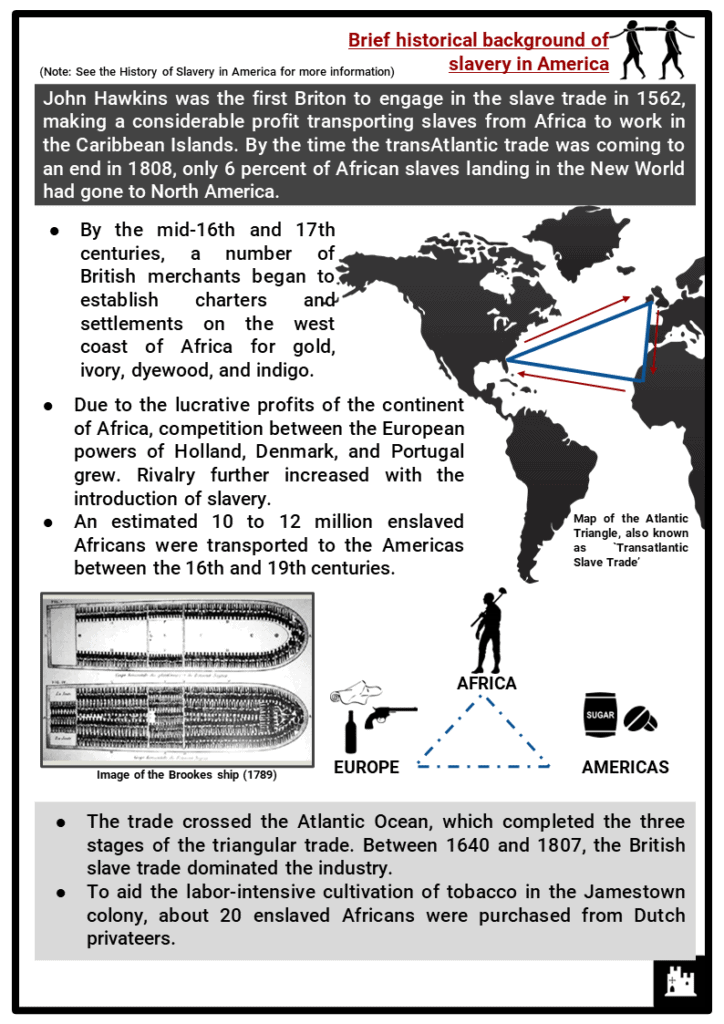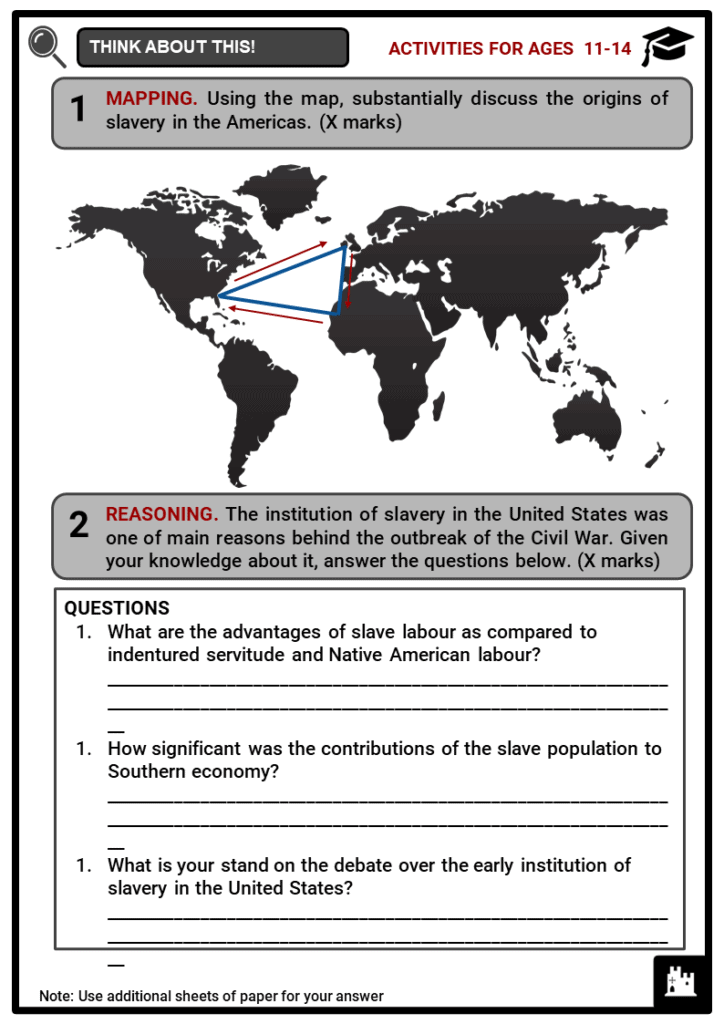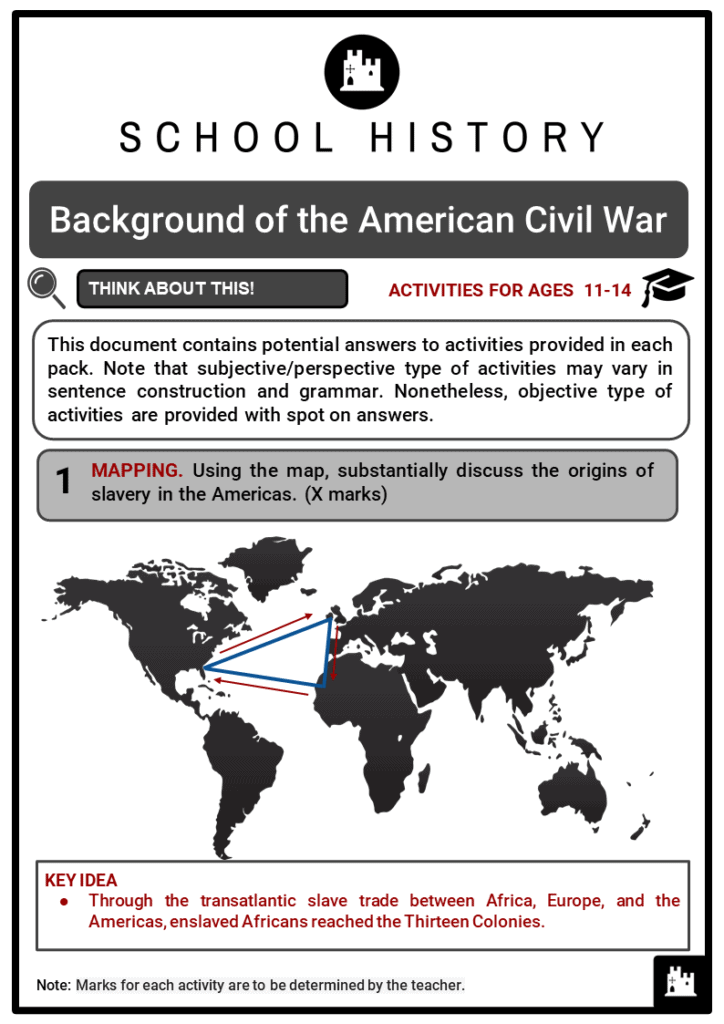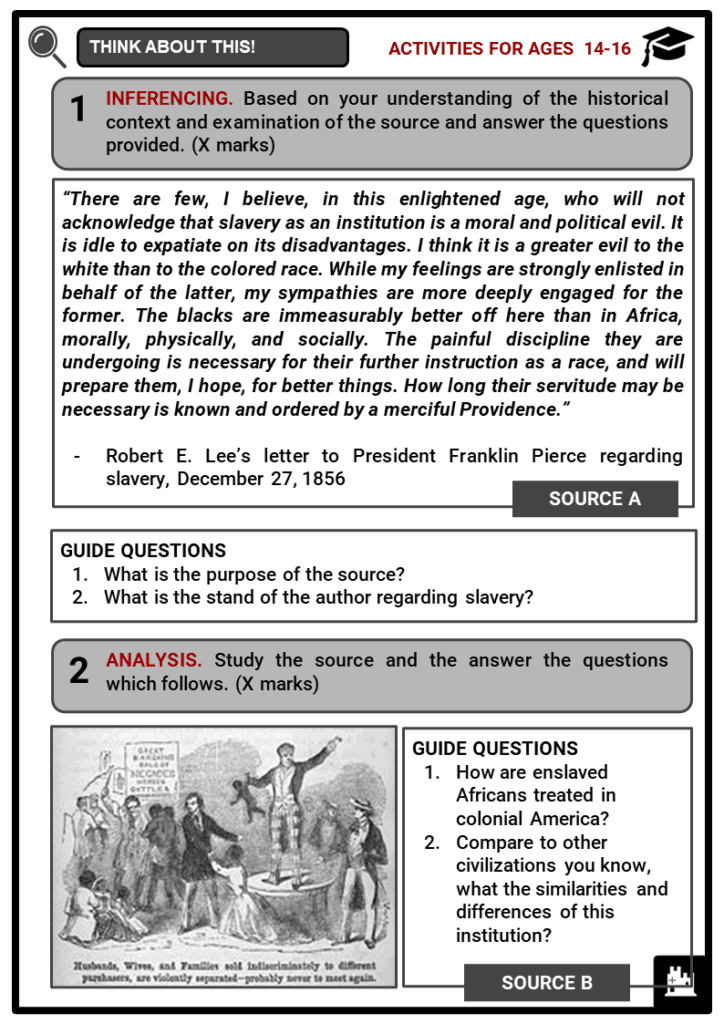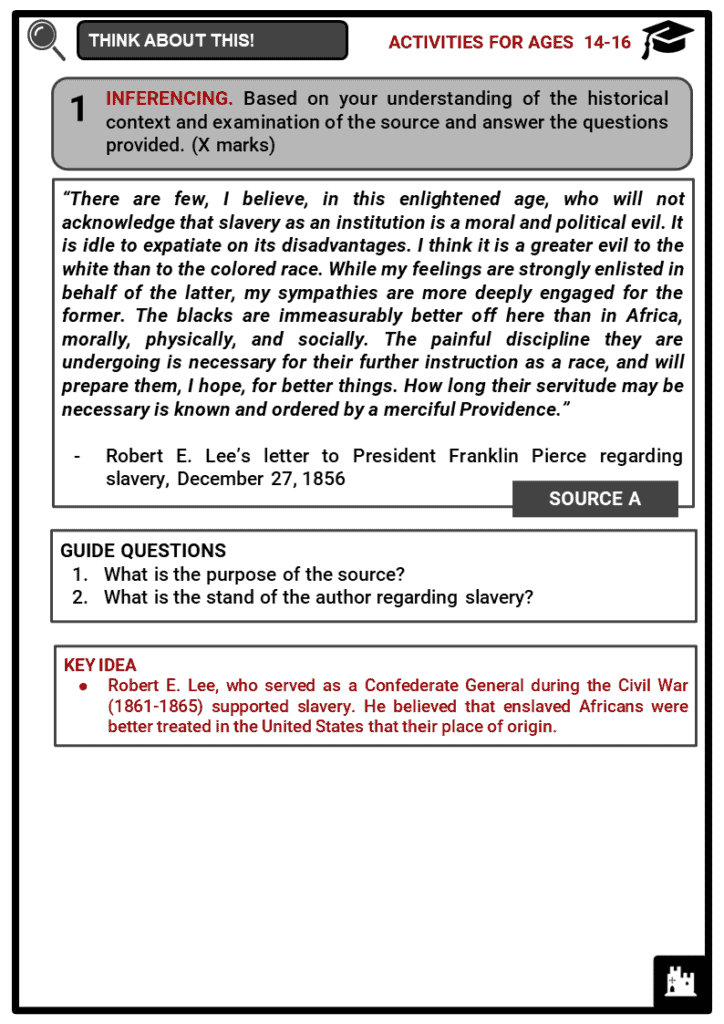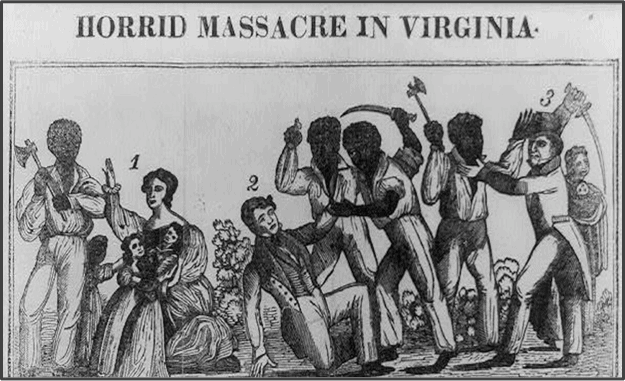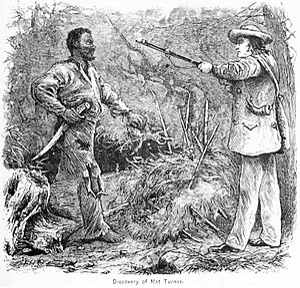Download Background of the American Civil War
Worksheets
Do you want to save dozens of hours in time? Get your evenings and weekends back? Be able to teach Background of the American Civil War to your students?
Our worksheet bundle includes a fact file and printable worksheets and student activities. Perfect for both the classroom and homeschooling!
Table of Contents
Add a header to begin generating the table of contents
Summary
- Brief historical background of slavery in America
- Key events which triggered the American Civil War
- The concepts of slavery, territorial expansion and politics
Key Facts And Information
Let’s know more about the background of the American Civil War
- The Civil War was a result of the interrelated issues of slavery, territorial and partisan political control. The tensions between the North and South were traceable to the origin and establishment of the Colonies.
Brief historical background of slavery in America
- John Hawkins was the first Briton to engage in the slave trade in 1562, making a considerable profit transporting slaves from Africa to work in the Caribbean Islands. By the time the transAtlantic trade was coming to an end in 1808, only 6 percent of African slaves landing in the New World had gone to North America.
- By the mid-16th and 17th centuries, a number of British merchants began to establish charters and settlements on the west coast of Africa for gold, ivory, dyewood, and indigo.
- Due to the lucrative profits of the continent of Africa, competition between the European powers of Holland, Denmark, and Portugal grew. Rivalry further increased with the introduction of slavery.
- An estimated 10 to 12 million enslaved Africans were transported to the Americas between the 16th and 19th centuries.
- The trade crossed the Atlantic Ocean, which completed the three stages of the triangular trade. Between 1640 and 1807, the British slave trade dominated the industry.
- To aid the labor-intensive cultivation of tobacco in the Jamestown colony, about 20 enslaved Africans were purchased from Dutch privateers.
- As demand for labor intensified, the British crown expanded the slave trade in its colonies in the Americas. Through the Navigation Act of 1660, only English-owned ships were allowed to enter its colonies.
- To further expand the slave trade monopoly, Charles II had sole rights to the Company of Adventurers Trading to Africa.
- Overseen by James, the Duke of York, British trade of gold, silver, and slaves to West Africa was monopolized.
- When white indentured servants began to leave the plantations, the labor system changed. Initially, Native Americans were forced to work on farms, however, the spread of European diseases eventually diminished their population.
- About 293,000 slaves lived in Virginia alone, making up 42% of all slaves in the US. Maryland, and North and South Carolina each had over 100,000 slaves. After the American Revolution, the South Slave population exploded to 1.1 million in 1810 and over 3.9 million by 1860.
- Aside from being suited to the tropical climate, enslaved Africans had skills in crop cultivation. Moreover, unlike American Indians, Africans had some immunity to tropical diseases like malaria and yellow fever. However, poor food supply and horrible working conditions contributed to their high mortality rate in the Americas, especially in the Caribbean.
- Enslaved Africans who arrived in the American colonies brought knowledge of cultivating to the tobacco and rice crops. Colonists knew little about cultivation.
Position of slaves in colonial America
- Due to relatively small populations in New England and the Middle Colonies (with only 3 to 6% slave population), slavery had minimal impact on colonial society compared to Chesapeake and South Carolina with a significant slave population.
- Like other colonial empires, slaves were at the bottom of the social hierarchy, with little to no legal rights. They were treated as property and sold in market places. Aside from working hard, the lives of slaves were entirely dependent on their owners.
- Among their treatment were as follows:
- Owners who sexually abused slaves were not punished
- Beating and killing of slaves was not covered by the law
- Plantation slaves were more overworked than those in urban areas
- Slaves were considered property and not people
- Even before the end of the TransAtlantic Slave trade, the South did not need a constant infusion of forced immigrants to work as slaves in their vast populations. This was in part due to the equal male to female ratio of slaves brought into the US in the 1730s to ‘50s that resulted in an increased birth rate among the slaves.
- Further, the mortality rates among the slaves after the gruesome expedition from the home country reduced dramatically. This was because the Southern region cultivated tobacco, and after the invention of the Cotton Gin in 1793, cotton crops grew half to three-quarters of the corn crop harvested between 1840 and 1860.
- Throughout the 19th Century, the US experienced tremendous growth that amplified the difference between the north and the southern states. In the North was manufacturing and industry with few small-scale farmers while the south had large-scale plantation farmers who mostly depended on slave labour for cash crops, such as cotton and tobacco.
- After the Revolutionary War, the original US Constitution acknowledged the system of slavery. Article 1, Section 2, also known as three-fifths compromise, stated that slaves counted as three-fifths of a person for the purpose of taxation and representation in Congress.
- The three-fifths compromise was debated among those who wanted to exclude and include slaves. Including all slaves meant increasing representation in slave states. Since slaves were not allowed to vote, such a representation issue only enabled slave states to count slaves among their population totals.
- Clause 1 of the original Constitution prohibited Congress from passing any laws banning slavery until 1808. It was only in 1807 when Thomas Jefferson, a known slave owner, Founding Father, and later US President, signed a bill banning slave trade. It took effect on January 1, 1808.
Examine the figures
- Between 1820 and 1860, the following states permitted slavery: Alabama, Arkansas, Delaware, Florida, Georgia, Kentucky, Louisiana, Maryland, Mississippi, Missouri, North Carolina, South Carolina, Tennessee, Texas, and Virginia.
- Under Section 2 of the Constitution, free states were prohibited from protecting slaves who escaped from states honouring the system.
Westward Expansion and statehood
- Following Thomas Jefferson’s Louisiana Purchase, territorial expansion and slavery became an intertwined cause. In order to balance power and vote to pass legislations, the Congress assured that there was an equal number of slave and free states.
- However, when new territories applied for statehood, Free and Slaves states extend influence to ensure both of their economic and political interests.
- This struggle of new territories on whether to permit slavery or not were initially addressed in 1820 through a compromise which established a line west of the Mississippi.
- However, political conflict between the North and the South continued in events, including the 1846 Wilmot Proviso, in 1854 Mexican-American War, 1850 Fugitive Slave Act and Compromise, 1854 Kansas-Nebraska Act, and the 1858 series of Lincoln-Douglas debates.
- Before the outbreak of the Civil War in 1861, there were 19 free states and 15 free states, commonly identified as the north and the south.
Key events which triggered the Civil War
- Prior to the 1861 Civil War, the United States of America was divided between the North and South. Disagreements regarding states’ rights, economy, tariffs, and slavery marked the demarcation line. In addition, continued westward expansion caused concern for the Southerners that new states would be admitted as free states. Here are some of the events before the outbreak of the Civil War in 1861.
Timeline Overview
- The 1820 Missouri Compromise
- Following Thomas Jefferson’s Louisiana Purchase, members of the Congress attempted to pass policies which did not only aim territorial expansion, but also the peculiar institution of slavery. In 1820, Missouri’s application for statehood as one of slave states caused great debate.
- Under the Missouri Compromise, the Congress agreed to admit Missouri as a slave state and Maine as a free state. In this case, the balance of the Congress remained. At the same time, this law prohibited slavery in Louisiana north of the 36° 30´ latitude line.
- On March 3, 1820, President James Monroe signed the bill into law. The following month, former President and principal author of the Declaration of Independence, Thomas Jefferson expressed his worries in a letter.
- 1831 Nat Turner’s Rebellion
- Nat Turner, a slave in southern Virginia led an uprising of about 70 enslaved African and killed about 60 white people. After two day of terror in several plantations, the militia infantry suppress the rebellion.
- After the insurrection, about 55 slaves were executed. Due to low success rates of slave rebellion in the south, Turner’s Rebellion is considered as the bloodiest.
-
- Despite the already limited right, lawmakers in Virginia further prohibited slaves from learning how to read and write.
- Moreover, slaves were not allowed to assemble. Working hours in a week were extended to prohibit slave from meeting with one another on Sundays.
- The 1846 Wilmot Proviso
- Proposed by Pennsylvania Congressman David Wilmot and supported by President James K. Polk, the Wilmot Proviso outlawed slavery in US-acquired territories as a result of the Mexican-American War
- When the Mexican-American War began in 1846, US President James K. Polk immediately sought the appropriation of $2 million to negotiate a treaty.
- After his election, Polk pushed for the acquisition of the territories of Oregon and Texas.
- Ceded territories included, California, Utah, Nevada and parts of Arizona, New Mexico, and Wyoming.
- This political measure later inspired politicians, like James Buchanan and John C. Calhoun in their own cause on slavery.
- The Compromise of 1850
- With ongoing national debate and souring relations in the Congress over the Wilmot Proviso, Senators Henry Clay and Stephen Douglas pursued the Compromise of 1850.
- On the other hand, slave states strengthened the enforcement of the Fugitive Slaves Act, which compelled free states to return escaped slaves to slave states. Texas was also compensated by the Congress with $10 million.
- Supported by US President Millard Fillmore, the compromise became a law in September.
- Also under the Compromise, slave trade was prohibited in Washington, D.C, but slaveholding was permitted.
- The 1854 Kansas- Nebraska Act
- In 1854, Kansas and Nebraska were established as territories. The decision to whether join the Union as a free or slave state lies on popular sovereignty. Under popular sovereignty as proposed by Stephen Douglas, residents of both territories would decide by popular referendum on allowing slavery or not.
- As a result, many northerners and southerners poured into Kansas to increased their number in the debate. In the fall of 1855, pro-slavery and anti-slavery advocates engaged in violence. This event became known as Bleeding Kansas.
- By the time Kansas joined the Union, the Civil War already began in 1861. This act divided Democrats and Whigs which later joined the new antislavery Republican Party.
- The 1857 Dred Scott Decision
- In 1857, the Dred Scott decision confirmed the legality of slavery in the southern states and the westward expansion, but the abolitionist movement convinced the southerners that the north was bent on dismantling the institution of slavery.
- Also known as Dred Scott v. Sanford, the case of freedom by an African slave lasted a decade. Dred Scott was born into slavery in 1799 in Virginia. He moved with his owner, Peter Blow to Alabama.
- By 1830, Scott moved to St Louis, Missouri. Both Alabama and Missouri were slave states.
- Two years later, Blow died and Scott was bought by Dr. John Emerson, who later moved him to Illinois and to Wisconsin territory - where slavery was outlawed under the Missouri Compromise.
- While in Wisconsin, Scott married Harriet Robinson, also a slave, who’s ownership was transferred to Emerson.
- In 1837, Emerson met and married Eliza Sanford when he moved to Louisiana, a slave state. After several months, Scott followed Emerson. By October 1838, the Emersons and their slaves returned to Wisconsin.
- In 1843, John Emerson died in Iowa. His slaves became his wife’s property. When Sanford returned to Missouri, he denied Scott from buying his freedom.
- Dred and Harriet Scott filed lawsuits against Irene Sanford in April 1846. Under two Missouri statutes, (1) Any person of any colour is allowed to sue for wrongful enslavement, and (2) Any person taken to a free territory would gain freedom and could not be subjected to slavery if returned to a slave state.
- The Scotts received support from abolitionists, church mates and the Blow family, who once own Dred.
- After retrial in 1850, Scott won his freedom. He lower court’s decision in 1852 was reversed by the Missouri Supreme Court. However, on May 15, 1854, Scott and his family became slaves again after the reversal of the federal court.
- On February 11, 1856, Scott’s trial reopen after his appeal to the US Supreme Court. The following year, he lost his fight for freedom. Chief Justice Roger Taney said that all people of African descent (free or slave) were not citizens of the United States, therefor had no right to sue. Moreover, he justified that under the Fifth Amendment, slaves were legal properties of their owners.
- 1858 Lincoln-Douglas Debates
- Between August 21 and October 15, 1858, Stephen Douglas and Abraham Lincoln faced each other in series of debates around the Illinois for a seat in the Senate.
- After 7 debates in several locations in the state, Douglas returned to Washington, while Lincoln was remember as a promising politician.
- Douglas argued that the most important decision on whether to permit slavery or not was the actions of the citizens. He stressed that no Supreme Court law could force its citizens. His idea later became known as the Freeport Doctrine, which gained popularity among the people, but equivalent to betrayal for many southern Democrats.
- Lincoln believed that African slaves were entitled to the rights stipulated in the Declaration of Independence. Douglass argued that the America’s Founding Fathers did not include them.
- 1860 Presidential Election
- With divided Democrats, Abraham Lincoln was elected as the 16th President of the United States in November 1860. He won the election with 180 electoral votes and less than 40% of the popular vote against candidates, Douglas, Breckenridge, and Bell.
- The 1860 election identified the Democratic and Republican Parties. It also intensified the division among slave and free states between the South and the North.
- Carrying anti-slavery platform of the new Republican Party, Lincoln’s election angered pro-slavery politicians. Because of this, even before Lincoln’s inauguration, eleven states seceded from the Union.
Image sources:


